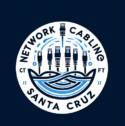How Significant Is Network Cabling in the Community?
In today’s digital age, network cabling plays a crucial role in keeping communities connected, productive, and informed. From local schools and hospitals to small businesses and smart homes, network cabling forms the unseen foundation that allows information to flow seamlessly every day. Without it, reliable communication, online learning, public safety systems, and even basic internet access wouldn’t be possible. Reliable connectivity plays a huge role in modern infrastructure, and our structured cabling experts in Santa Cruz ensure every installation meets the highest standards of performance and safety.
What Is Network Cabling?
Network cabling refers to the structured system of cables and hardware that connects devices to the internet and to each other. It enables data transfer between computers, servers, phones, and other digital systems.
The most common types include:
- CAT5e and CAT6 cables – Used for Ethernet networks in homes and businesses
- Fiber optic cables – Provide lightning-fast connections across long distances
- Coaxial cables – Often used for television and broadband networks
Each type plays an important role in ensuring smooth communication, fast data speeds, and consistent connectivity across communities.
How Network Cabling Impacts Local Communities
Network cabling isn’t just a technical necessity — it’s the backbone of modern life. Its impact can be seen in nearly every part of society:
1. Education
Schools and universities rely on strong network cabling systems for online learning, digital classrooms, and administrative communication. With high-speed cabling, students and teachers can collaborate, stream lessons, and access cloud-based tools without interruption.
2. Healthcare
Hospitals and clinics use network cabling for patient monitoring, telemedicine, and secure data storage. A stable cabling infrastructure ensures that medical professionals can share information in real time and deliver timely care.
3. Local Businesses
Small businesses depend on reliable internet and communication systems for transactions, customer service, and online marketing. Structured cabling supports point-of-sale systems, VoIP phones, and security networks that keep operations running smoothly.
4. Public Safety
Police stations, fire departments, and emergency services use network cabling to communicate quickly and share critical information. Reliable connectivity ensures timely responses and coordination during emergencies.
5. Residential Connectivity
At home, network cabling supports everything from streaming and gaming to smart home systems. Fiber and CAT6 cabling have become standard for homeowners who want consistent speed and performance across multiple devices.
Why Proper Network Cabling Design Matters
A poorly designed or outdated cabling system can cause slow speeds, network drops, and expensive maintenance issues. When communities invest in structured cabling, they get systems that are:
- Scalable – Easy to expand as technology evolves
- Efficient – Reduces signal interference and downtime
- Organized – Neat cable management that simplifies troubleshooting
- Reliable – Delivers consistent performance for years
Professional installation ensures that cables are properly terminated, labeled, and tested — saving time and money in the long run.
Network Cabling and the Digital Divide
One of the biggest challenges in many communities is the digital divide — the gap between those with access to reliable internet and those without. Quality cabling infrastructure helps bridge this gap by improving connectivity in schools, libraries, and low-income areas.
Cities and local governments across California and the U.S. are now investing in fiber network expansion projects to bring high-speed internet to underserved neighborhoods. These initiatives help create more inclusive and connected communities.
The Future of Network Cabling in Communities
As the demand for data grows, communities are shifting toward fiber optic cabling and CAT6a or CAT7 structured systems. These upgrades support future technologies like 5G, smart cities, and the Internet of Things (IoT).
Modern network cabling is paving the way for:
- Smart infrastructure (traffic management, public Wi-Fi)
- Remote education and work-from-home access
- Cloud-based city services
- Expanded digital healthcare and telemedicine
Conclusion: A Connected Community Is a Stronger Community
Network cabling may not always be visible, but it plays an essential role in modern society. It powers the internet connections that help people learn, communicate, and stay safe. Discover more about why network cabling is important for today’s digital infrastructure.
Investing in reliable network cabling infrastructure helps communities thrive — enabling economic growth, digital inclusion, and technological advancement for everyone.
Whether you’re a business owner, school administrator, or local planner, prioritizing structured cabling means building a foundation for a more connected and resilient community.
